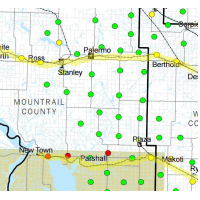Trains Full of Toxic Oil Run Next to Nuclear Missile Silos
 Red, Yellow and Green dots are missile sites. (graphic: Minot Air Force Base Joint Land Use Study)
Red, Yellow and Green dots are missile sites. (graphic: Minot Air Force Base Joint Land Use Study)
On February 16, a train full of volatile oil from North Dakota’s Bakken fields derailed and caught fire in Mount Carbon, West Virginia. It forced the evacuation of hundreds of families and since two cars went into the Kanawha River, two water treatment plants were shut down. The train and its cargo burned for days because there’s not really a protocol for putting out a fire fueled by 3 million gallons of volatile crude.
Believe it or not, that train wreck was a best-case scenario. Earlier in its journey from western North Dakota, that train had passed just a few hundred feet from a fully fueled and armed nuclear missile. The consequences of a similar derailment and fire next to a missile silo could have been a true catastrophe.
One-third of the missiles controlled by Minot Air Force Base in North Dakota are in the Bakken oil field and the trains carrying much of that volatile output pass in close proximity to many missile sites, according to a report (video) on MSNBC’s “The Rachel Maddow Show.”
Air Force documents obtained by the show highlight the Pentagon’s concern about the problem. A Master Conflict Table (pdf) shows a problem with a Canadian Pacific rail spur that crosses a 1,200-foot easement around a missile launch facility (MLF), or silo. “Construction may cause vibrations that may impact MLFs and includes the presence of civilians adjacent to a MLF, posing potential security concerns. Increases threat from derailment adjacent to MLF. Hazardous contents of rail cars present safety concern within 1,200-foot easement,” the entry reads.
A second table (pdf) puts the danger in more general terms. “Rail oil cars in close proximity to MLFs and MAFs (missile alert facility, or control room) poses a man-made disasters concern,” according to the Air Force.
A nuclear expert quoted in the MSNBC report said, “You have a potential disaster on your hands, with not just casualties in the immediate area, but radioactive contamination and fallout all around.”
-Steve Straehley
To Learn More:
U.S. Military Concerned About Oil Train Proximity to Missile Sites (video) “The Rachel Maddow Show,” MSNBC
Missile Sites, Oil Wells Co-Existing (by Lauren Donovan, Bismarck Tribune)
In West Virginia, a Collective Sigh After the Chaos (by Lexi Belculfine, Pittsburgh Post-Gazette)
Master Conflict Table (pdf) (U.S. Air Force)
Master Conflict Table 2 (pdf) (U.S. Air Force)
Missile Site Encroachments, Minot Air Force Base Area (pdf) (Minot Air Force Base Joint Land Use Study)
With Domestic Oil Production at 27-Year High and Increased Rail Shipments, Rail Accidents are Actually Declining in Frequency (by Noel Brinkerhoff, AllGov)
More Oil Spilled from Trains Last Year than in Previous 37 Years Combined (by Noel Brinkerhoff, AllGov)
- Top Stories
- Unusual News
- Where is the Money Going?
- Controversies
- U.S. and the World
- Appointments and Resignations
- Latest News
- Musk and Trump Fire Members of Congress
- Trump Calls for Violent Street Demonstrations Against Himself
- Trump Changes Name of Republican Party
- The 2024 Election By the Numbers
- Bashar al-Assad—The Fall of a Rabid AntiSemite






Comments